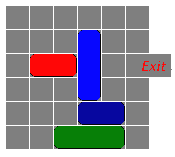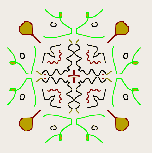What's New - January 2002
[Home]
|
January 30, 2002: Here's puzzle/game I call Traffic Jam. It's modeled after the original plastic version, RushHour, by Binary Arts. The objective is to free the target car by moving those that are blocking it's way. Vehicles can move only in the direction of their long axis. A simple case with the objective of moving the red car to the exit looks like this:
January 17,2002: Sliding Coins:
The problem is to get
from Here's a minor update to the previously posted Sliding Coins puzzle - it improves colors and the dragging of coins. Not really very significant, just one of those "30 minute" changes that took a week to do. Good programmers, bulldogs, and other overachievers share one characteristic - we just don't give up.
January 14, 2002: A month or so ago we introduced the T-Shirts 2 problem - find N digit numbers that are equal to the sum of the Nth powers of their digits. For example, 153= 13+53+33, 1634=14+64+34+44, etc. Numbers with this characteristic are called Armstrong numbers or Pluperfect Digital Invariants. In base 10, it turns out that there are 88 of them, the largest containing 39 digits! Calculating these numbers is non-trivial once we get over 10 digits or so - more of the kind of stuff that PhD's get paid to play with. Here's the version I call T-Shirts2-XXL, that will do them all (although I haven't done it yet). In the process I found and fixed a small error in the "Add" operator in the Big Integers unit. If you have previously downloaded the unit, do it again. (Or if you download T-Shrts2 XXL source, the new version is included)
January 2, 2002: It looks like the holidays are winding down - we plan a trip to Alabama this coming weekend to help granddaughter Sarah celebrate her 8th birthday then we'll get going on DFF projects again. Spent a pleasant few days working with Chris (7) on his Pinewood Derby car, practicing trumpet duets with Kaitlin (10), and working with both on the "Logical Journey of the Zoombinis" - still one of the best games around. They are getting better than me at solving the puzzles there though - scary!. While browsing DFF the other day, I ran across a note in the Scientific Grapher program write-up that promised more information on converting from Polar to Cartesian coordinate systems; necessary in order to display some graphs. Today I posted this graphical demo of Polar-Cartesian coordinate conversion over in Math-Topics. |



 January
20, 2002: How many ways can we make change for $1 using the
six coin values ($1, 50c, 25c, 10c, 5c, 1c)? The answer is well
known, but here's a
January
20, 2002: How many ways can we make change for $1 using the
six coin values ($1, 50c, 25c, 10c, 5c, 1c)? The answer is well
known, but here's a  January
15, 2002: T-Shirts 2 XXL just completed finding all 88 Armstrong
numbers (see below if you don't know what they are). Here's
January
15, 2002: T-Shirts 2 XXL just completed finding all 88 Armstrong
numbers (see below if you don't know what they are). Here's  January 11, 2002: We're back! Here's
version 1 of a
January 11, 2002: We're back! Here's
version 1 of a